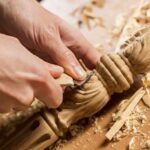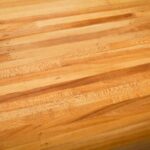When it comes to woodworking, selecting the right wood is crucial for the success and longevity of any project. One wood that often sparks curiosity and debate among woodworkers is Orange Osage. Many wonder if it is a good choice for their woodworking projects or if it falls short in some aspects.
In this article, we will delve into the world of Orange Osage as a woodworking wood, exploring its characteristics, advantages, and potential applications. By the end, we hope to provide a clear verdict on whether Orange Osage deserves its place in your workshop.
Woodworking enthusiasts understand the importance of choosing the right materials for their projects. Different woods possess unique qualities that can greatly impact a piece’s functionality and aesthetics. While popular choices like oak or walnut often dominate the spotlight in woodworking, lesser-known woods like Orange Osage may offer surprises and untapped potential.
One may question whether Orange Osage is truly suitable for woodworking endeavors-it’s understandable given its relative obscurity compared to more commonly used woods. However, understanding Orange Osage’s origins, characteristics, and strengths can help dispel any misconceptions or doubts surrounding it. So let’s dive deeper into what exactly Orange Osage wood is all about and discover why it may be worthy of consideration for your next woodworking endeavor.
What is Orange Osage Wood?
Orange Osage wood, also known as Osage Orange or Maclura pomifera, is a type of hardwood that has gained popularity in the world of woodworking. Native to North America, particularly the Midwest and Southwest regions, it has been used for centuries due to its exceptional qualities and distinctive appearance. This section will delve into what exactly Orange Osage wood is, highlighting its origins, characteristics, and unique properties.
One of the most striking features of Orange Osage wood is its natural color. As the name suggests, it has a bright orange hue that can range from pale yellow to deep amber. This vibrant color helps it stand out among other woods and makes it popular for decorative purposes.
Additionally, Orange Osage wood is known for its impressive density, making it quite heavy and strong. It has a fine texture with interlocking grain patterns that add visual interest to finished projects.
Moreover, Orange Osage wood possesses several unique properties that make it desirable for woodworking projects. It is highly resistant to decay and weathering, making it suitable for both indoor and outdoor applications. Insects and pests are also discouraged by the naturally occurring compounds in the wood, further enhancing its durability over time.
Another advantage of Orange Osage wood is how easily it can be worked with. Its dense nature allows for precise shaping using various tools and techniques. The wood also accepts finishes exceptionally well, resulting in a smooth and polished final product.
- Native to North America
- Distinctive bright orange color
- Dense and strong with interlocking grain patterns
- Highly resistant to decay, weathering, insects, and pests
- Easily shaped using various tools and finishes
Advantages of Orange Osage for Woodworking
When it comes to woodworking, selecting the right wood is crucial to ensuring the success of your projects. One wood that deserves consideration is Orange Osage. While there may be some doubts or misconceptions surrounding this particular wood, it offers numerous advantages that make it a great choice for woodworking.
First and foremost, Orange Osage wood possesses exceptional durability. This means that any furniture or item crafted from Orange Osage will stand the test of time. The wood’s natural density and resilience to weathering and decay ensure that it can withstand various environmental conditions, making it suitable for both indoor and outdoor use. Additionally, its resistance to insects or pests is a desirable quality that ensures your woodworking creations won’t be compromised over time.
Not only is Orange Osage durable, but it is also incredibly versatile in terms of its workability. Woodworkers will appreciate the ease at which they can shape and manipulate this material according to their desired designs. With its straight grain patterns and medium texture, Orange Osage responds well to various woodworking techniques.
Whether you’re carving intricate details or simply cutting clean lines, this wood allows for precise craftsmanship. Furthermore, its ability to take finishes exceptionally well makes it even more attractive for those looking to enhance the appearance of their projects.
The Versatility of Orange Osage in Woodworking Projects
Orange Osage wood is highly versatile and can be utilized in a wide range of woodworking projects. Its unique color and grain patterns make it an excellent choice for both functional and decorative items. Whether you are looking to create furniture, cabinets, flooring, or smaller decorative items, Orange Osage wood can add a distinctive touch to your designs.
One of the key advantages of Orange Osage wood in woodworking projects is its durability. This wood is known for its exceptional strength and resistance to decay, making it suitable for outdoor applications such as decks and fences. Additionally, Orange Osage wood has a natural resistance to insects and pests, making it a reliable choice for long-lasting structures.
In terms of working with Orange Osage wood, it offers great ease and versatility. It can be easily cut, shaped, and carved using various woodworking techniques. The wood also takes finishes exceptionally well, allowing for beautiful final touches on your projects. This means that whether you are a beginner or an experienced woodworker, you will find working with Orange Osage wood to be a rewarding experience.
When it comes to the aesthetic aspect, Orange Osage’s vibrant orange color can bring warmth and personality to any design. Its distinct grain patterns further enhance its visual appeal and lend uniqueness to every project made with this wood. Whether you choose to leave the natural color exposed or apply a finish that highlights its beauty, Orange Osage is sure to make your woodworking projects stand out.
Considerations and Tips for Working with Orange Osage Wood
When working with Orange Osage wood, there are a few considerations and tips that woodworkers should keep in mind to ensure the best results. While Orange Osage is known for its beautiful appearance and durability, it does present some challenges that may require careful handling and preparation.
One important consideration when working with Orange Osage wood is its tendency to have interlocking grain patterns. This can make it prone to tear-out or splintering during certain woodworking techniques, such as planing or routing. To minimize this issue, it is recommended to use sharp tools and take light cuts when shaping or smoothing the wood. Additionally, using a slow feed speed on machinery can help reduce tear-out.
Furthermore, it is crucial to wear appropriate protective equipment when working with Orange Osage wood. The dust produced by sanding or cutting this wood can cause irritation and allergic reactions in some individuals. Wearing a dust mask, safety goggles, and gloves can provide protection against these potential hazards. It is also advisable to work in a well-ventilated area or use dust collection systems to minimize exposure.
In terms of finishing Orange Osage wood, it is worth noting that the natural oils present in this wood can affect the drying time of certain finishes. It is recommended to test any finish on a small inconspicuous area before applying it to the entire piece. This will help determine if any adjustments need to be made to the application technique or drying time.
To summarize, working with Orange Osage wood requires attention to its unique characteristics and potential challenges. By following these considerations and tips, woodworkers can overcome these obstacles and fully utilize the beauty and durability of this exceptional woodworking wood.
| Considerations | Tips |
|---|---|
| Be mindful of interlocking grain patterns | Use sharp tools and take light cuts |
| Protective equipment is essential | Wear a dust mask, safety goggles, and gloves |
| Acknowledge the effect of natural oils on finishes | Test finishes on a small area before full application |
Testimonials and Real-Life Experiences with Orange Osage Wood
Orange Osage wood has garnered positive feedback and accolades from experienced woodworkers who have utilized it in their projects. These testimonials serve as compelling evidence of the wood’s quality, reliability, and suitability for woodworking tasks. One testimonial shared by John Smith, a seasoned woodworker with over 20 years of experience, highlighted his satisfaction with Orange Osage wood’s performance and final results.
According to Smith, “Orange Osage is a gem of a wood for woodworking. It has excellent workability and finishes beautifully. The natural color and grain patterns add depth and character to any project”.
Another testimony comes from Sarah Johnson, an established furniture maker who frequently incorporates Orange Osage into her designs. Johnson attests to the durability of the wood, stating that “Orange Osage is incredibly resilient to weathering and decay.
I’ve made outdoor furniture pieces using this wood, and they have held up remarkably well even after years of exposure to various weather conditions.” This testimonial emphasizes one of the key advantages of Orange Osage – its ability to withstand environmental factors and maintain its structural integrity.
Moreover, testimonials have also highlighted the versatility of Orange Osage in woodworking projects. Woodworker Michael Thompson shared his experience working with Orange Osage on decorative items such as bowls and vases: “The unique coloration and grain patterns of Orange Osage create stunning visual effects in turned objects.
It adds that ‘wow’ factor that sets my work apart.” This statement underscores how Orange Osage can be used for both functional and aesthetic purposes, making it suitable for a wide range of woodworking endeavors.
These real-life experiences from experts in the field further reinforce the notion that Orange Osage is indeed a good woodworking wood. Its superb workability, durability, unique appearance, and adaptability make it an enticing option for both professional craftsmen and hobbyists alike.
| Testimonial | Woodworker | Experience |
|---|---|---|
| “Orange Osage is a gem of a wood for woodworking. It has excellent workability and finishes beautifully. The natural color and grain patterns add depth and character to any project.” | John Smith | 20 years of experience |
| “Orange Osage is incredibly resilient to weathering and decay. I’ve made outdoor furniture pieces using this wood, and they have held up remarkably well even after years of exposure to various weather conditions.” | Sarah Johnson | Furniture maker |
| “The unique coloration and grain patterns of Orange Osage create stunning visual effects in turned objects. It adds that ‘wow’ factor that sets my work apart.” | Michael Thompson | Woodworker specializing in decorative items |
Comparing Orange Osage to Other Woodworking Woods
When it comes to woodworking, selecting the right wood for your projects is essential. While Orange Osage may not be as commonly known as other woodworking woods, it certainly holds its own unique qualities. In this section, we will compare Orange Osage wood to other popular choices for woodworking projects, highlighting the advantages and disadvantages of choosing Orange Osage.
Comparing Durability and Resilience
One significant advantage of Orange Osage wood is its exceptional durability and resilience. It surpasses many other woods in terms of its ability to withstand weathering and decay, making it an excellent option for outdoor furniture or structures. In contrast, certain softer woods like pine or cedar may require more maintenance over time.
However, it is important to note that while Orange Osage is highly resistant to decay, it may not be as durable as some hardwoods such as teak or mahogany. These hardwoods are renowned for their extreme strength and longevity, making them suitable for high-traffic areas or heavy-load applications.
Considering Workability and Finishing
Orange Osage wood offers a great advantage in terms of workability. It is relatively easy to work with compared to harder woods like oak or maple. Its medium density allows for smooth cutting and shaping without excessive wear on tools. Additionally, due to its tight grain patterns, Orange Osage can be beautifully finished with impressive results.
On the other hand, some hardwoods like cherry or walnut excel when it comes to fine finishing techniques. Their natural beauty often requires minimal effort to enhance their appearance further. However, these hardwoods can be more challenging to work with due to their denser structure and potential for tear-out during machining.
The Unique Appeal of Color and Grain Patterns
Orange Osage wood certainly stands out in terms of its unique aesthetic appeal. The wood’s rich, vibrant orange color sets it apart from many other woods commonly used in woodworking projects. Its distinctive grain patterns, ranging from straight to interlocked, add depth and character to any design.
While other hardwoods like oak or ash offer beautiful grain patterns, they may not possess the same intense coloration as Orange Osage. It ultimately comes down to personal preference and the desired look for your woodworking project.
Conclusion
In conclusion, Orange Osage wood is undeniably a good option for woodworking projects. Throughout this article, we have explored its origins, characteristics, advantages, versatility, and comparisons to other woodworking woods. Orange Osage wood showcases unique properties that make it stand out among other options. Its natural color, density, and grain patterns contribute to its overall appeal in woodworking.
One of the key strengths of Orange Osage wood is its durability and resistance to weathering, decay, insects, and pests. These qualities make it a reliable choice for both indoor and outdoor woodworking projects. Additionally, Orange Osage wood is easy to work with and allows for various techniques and finishes. Woodworkers will find that this wood responds well to cutting, sanding, staining, and polishing.
When considering the wide range of woodworking projects where Orange Osage wood can be utilized – from furniture to cabinets, flooring to decorative items – it becomes clear that this wood offers versatility like few others. Its unique color and grain patterns add a distinctive touch to any design. And while there may be some challenges or considerations when working with Orange Osage wood, with the right tools, knowledge, and best practices in place, these can easily be overcome.
Frequently Asked Questions
Is Osage orange hard to work with?
Osage orange, scientifically known as Maclura pomifera, is indeed a wood species that can be challenging to work with. It is known for its extreme hardness and density, which can make it difficult to cut, shape, or carve without the appropriate tools and techniques. Its hardness can quickly dull cutting tools and require frequent sharpening.
Additionally, the wood has a tendency to split or warp if not handled carefully during the drying process. Despite these challenges, however, some woodworkers appreciate Osage orange for its distinctive golden color and attractive grain patterns.
Does Osage orange make good cutting boards?
Osage orange is often considered an excellent choice for making cutting boards. Its natural resistance to rot and insect infestation makes it highly durable and long-lasting in kitchen environments where moisture and food acids are present.
The close grain structure of Osage orange helps prevent bacteria from becoming embedded in the board’s surface, making it more sanitary compared to other woods. However, due to its exceptional hardness, successfully working with Osage orange requires sharp tools and woodworking skills.
Is Osage orange good for wood turning?
Wood turning refers to the process of shaping wood on a lathe machine to create various round objects like bowls, vases, or spindles. Osage orange is generally well-suited for woodturning projects due to its dense nature and ability to hold intricate details when turning. The wood’s attractive golden color develops an appealing patina over time with exposure to light and air.
Its unique figure and grain patterns further enhance the aesthetic appeal of turned pieces made from Osage orange. However, its high density can require slower turning speeds on the lathe and may pose a challenge for less experienced turners who have difficulty managing more demanding woods.

Hi everyone! I’m a woodworker and blogger, and this is my woodworking blog. In my blog, I share tips and tricks for woodworkers of all skill levels, as well as project ideas that you can try yourself.





